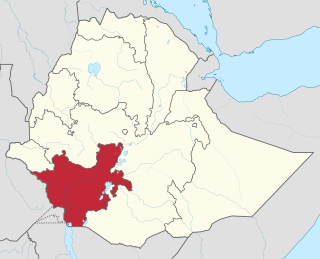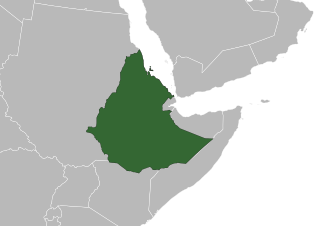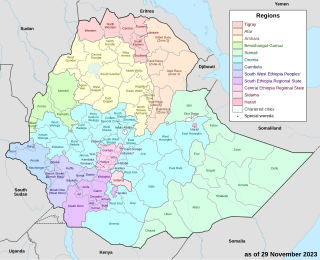Related Research Articles

Haile Selassie I was Crown Prince and Regent of the Ethiopian Empire from 1916 to 1928, and then King and Regent from 1928 to 1930, and finally Emperor from 1930 to 1974. He is a defining figure in modern Ethiopian history. He was a member of the Solomonic dynasty who traced his lineage to Emperor Menelik I.

Ethiopia, officially the Federal Democratic Republic of Ethiopia, is a landlocked country in the Horn of Africa. It shares borders with Eritrea to the north, Djibouti to the northeast, Somalia and Somaliland, which is Internationally recognised to be an autonomous region of Somalia, to the east, Kenya to the south, South Sudan to the west and Sudan to the northwest. With over 109 million inhabitants, Ethiopia is the most populous landlocked country in the world and the second-most populous nation on the African continent with a total area of 1,100,000 square kilometres (420,000 sq mi). Its capital and largest city is Addis Ababa, which lies a few miles west of the East African Rift that splits the country into the Nubian and Somali tectonic plates.

The Ethiopian Orthodox Tewahedo Church is the largest of the Oriental Orthodox Christian churches. One of the few pre-colonial Christian churches in Sub-Saharan Africa, the Ethiopian Orthodox Tewahedo Church has a membership of between 45 and 50 million people, the majority of whom live in Ethiopia. It is a founding member of the World Council of Churches. The Ethiopian Orthodox Tewahedo Church is in communion with the Eritrean Orthodox Tewahedo Church, the Coptic Orthodox Church of Alexandria, the Syriac Orthodox Church, the Armenian Apostolic Church, and the Malankara Orthodox Syrian Church, having gained autocephaly in 1959.

Southern Nations, Nationalities, and Peoples' Region is one of the nine ethnically based regional states (kililoch) of Ethiopia. It was formed from the merger of five kililoch, called Regions 7 to 11, following the regional council elections on 21 June 1992. Its capital is Awasa.
Beta Israel, also known as Ethiopian Jews, are a Jewish community that developed and lived for centuries in the area of the Kingdom of Aksum and the Ethiopian Empire, which is currently divided between the modern-day Amhara and Tigray regions of Ethiopia as well as Eritrea. Most of the community emigrated to Israel in the late 20th century.

Habeshapeoples: Ge'ez: ሐበሻ /Habesha/ or /Abesha/ is a common pan-ethnic and meta-ethnic term used to refer to both Ethiopians and Eritreans as a whole. Conservatively-speaking with a narrow archaic definition, the Ethiosemitic-speaking and Agwa-speaking Cushitic peoples inhabiting the highlands of Ethiopia and Eritrea were considered the core linguistically, culturally and ancestrally related ethnic groups that historically constituted the pan-ethnic group Habesha peoples, but in a more broader contemporary sense includes all Ethiopian-Eritrean ethnic groups. Members’ culture and ancestry trace back to the Kingdom of Dʿmt, the Kingdom of Aksum, and the various constituaient kingdoms and predecessor states of the Ethiopian Empire in the Horn of Africa. Some Scholars have classified the Tigrayans and the Amhara as “Abyssinians proper” under an ultra-neo-conservative theory postulated by a few scholars and political parties but not widely accepted by the general public or by most indigenous scholars of the region.
The languages of Ethiopia refers to the various spoken forms of communication in Ethiopia. It includes the nation's official languages, its national and regional languages, as well as its minority and foreign languages.

Semien Omo(English: North Omo) was a Zone in the Ethiopian Southern Nations, Nationalities, and Peoples' Region (SNNPR). It was named after the Omo River, which flows in the western area of the former zone. In 2000 it was split into three zones: Dawro, Gamo Gofa, and Wolayita; and Basketo and Konta became special woredas.
Wolaytta is a North Omotic language of the Ometo group spoken in the Wolayita Zone and some other parts of the Southern Nations, Nationalities, and People's Region of Ethiopia. It is the native language of the Welayta people. The estimates of the population vary greatly because it is not agreed where the boundaries of the language are.
The Ometo languages of Ethiopia are a dialect cluster of the Omotic family, generally accepted as part of the Afro-Asiatic language family. They include the most populous Omotic language, Wolaytta, with two million speakers. The languages have around 4 million speakers.
The Welayta, Wolayta or Wolaitta are an ethnic group and its former kingdom, located in southern Ethiopia. According to the most recent estimate (2017), the people of Wolayta numbered 2.4 million in Welayta Zone only, or 2.31 percent of the country's population, of whom 289,707 are city-dwellers. The language of the Wolayta people, similarly called Wolaytta, belongs to the Omotic branch of the Afro-Asiatic language family. Despite their small population, Wolayta people have widely influenced national music, dance and cuisine in Ethiopia.
Gofa Zone was one of the 17 Zones in the Southern Nations, Nationalities, and Peoples' Region of Ethiopia. Part of the Southern Nations, Nationalities, and Peoples' Region, Gofa Zone was bordered on the south by Kamba and Daramalo woredas, on the southwest by the Debub (South) Omo Zone, on the west by the Basketo special woreda, on the northwest by Dawro Zone, on the north by the Dawro Zone, and on the east by Kucha. The administrative center of Gofa Zone is Sawla; other towns included Bulki. Gofa Zone was separated for Demba Gofa Woreda, Geze Gofa Woreda, Zala Woreda, Malo Koza Woreda, Gada Woreda, Uba Debretsehay Woreda, Oyda Woreda and the two town Administrations Sawla town and Bulki town.
Zala Ubamale was one of the 77 woredas in the Southern Nations, Nationalities, and Peoples' Region of Ethiopia. Part of the Gamo Gofa Zone, Zala Ubamale was bordered on the south and west by the Debub Omo Zone, on the northwest by Gofa Zuria, on the northeast by Kucha, on the east by Dita Dermalo and on the southeast by Kemba. Towns in Zala Ubamale included Beto and Meleante. Zala Ubamale was divided for Uba Debretsehay and Zala woredas.

The Ethiopian Empire, also known by the exonym Abyssinia, or just simply Ethiopia, was a monarchy that spanned a geographical area in the current states of Ethiopia and Eritrea. It began with the establishment of the Solomonic dynasty by Yekuno Amlak from approximately 1270 and lasted until 1974, when Emperor Haile Selassie was overthrown in a coup d'état by the Communist Derg. It was throughout much of its existence the most powerful state in the African Horn and managed to preserve and develop its ancient form of Christianity.

Sawla is a town in southern Ethiopia. Located in Gamo Gofa Zone of the Southern Nations, Nationalities and Peoples' Region, this town has a latitude and longitude of 6°18′N36°53′E with an elevation of 1,395 metres (4,577 ft) above sea level. It is surrounded by Demba Gofa woreda.
Basketo is an Afro-Asiatic language spoken in the Basketo special woreda of the Southern Nations, Nationalities, and Peoples Region, which is part of Ethiopia. The speakers refer to the language as "Masketo", while their neighbors refer to it as "Basketo." It has said to consist of two dialects, "Doko" (Dokko) and "Dollo" (Dollo). Besides their mother tongue, some also speak Melo, Oyda, Galila, or Gofa.
Demba Gofa is one of the woredas in the Southern Nations, Nationalities, and Peoples' Region of Ethiopia. Part of the Gamo Gofa Zone, Demba Gofa is bordered on the south by Uba Debretsehay and Oyda, on the west by Geze Gofa, on the northwest by Melokoza, on the north by the Dawro Zone, on the east by Kucha, and on the southeast by Zala. Sawla is surrounded by Demba Gofa. Demba Gofa was part of former Gofa Zuria woreda.
Uba Debretsehay is one of the woredas in the Southern Nations, Nationalities, and Peoples' Region of Ethiopia. Part of the Gamo Gofa Zone, Uba Debretsehay is bordered on the south and west by the Debub Omo Zone, on the north by Oyda and Demba Gofa, on the northeast by Zala, and on the east by Kemba. Towns in Uba Debretsehay include Beto. Uba Debretsehay was part of former Zala Ubamale woreda.
Geze Gofa is one of the woredas in the Southern Nations, Nationalities, and Peoples' Region of Ethiopia. Part of the Gamo Gofa Zone, Geze Gofa is bordered on the south by Oyda, on the west by Basketo special woreda, on the northwest by Melokoza, and on the east by Demba Gofa. Towns in Geze Gofa include Bulki. Geze Gofa was part of former Gofa Zuria woreda.
Oyda is one of the woredas in the Southern Nations, Nationalities, and Peoples' Region of Ethiopia. It is named after Oyda people living in this woreda. Part of the Gamo Gofa Zone, Oyda is bordered on the south by Uba Debretsehay, on the west by the Debub Omo Zone, on the north by Geze Gofa, and on the northeast by Demba Gofa. Oyda was part of former Gofa Zuria woreda.
References
- 1 2 Oyda at Ethnologue (18th ed., 2015)
- ↑ Hammarström, Harald; Forkel, Robert; Haspelmath, Martin, eds. (2017). "Oyda". Glottolog 3.0 . Jena, Germany: Max Planck Institute for the Science of Human History.
- ↑ http://www.csa.gov.et/